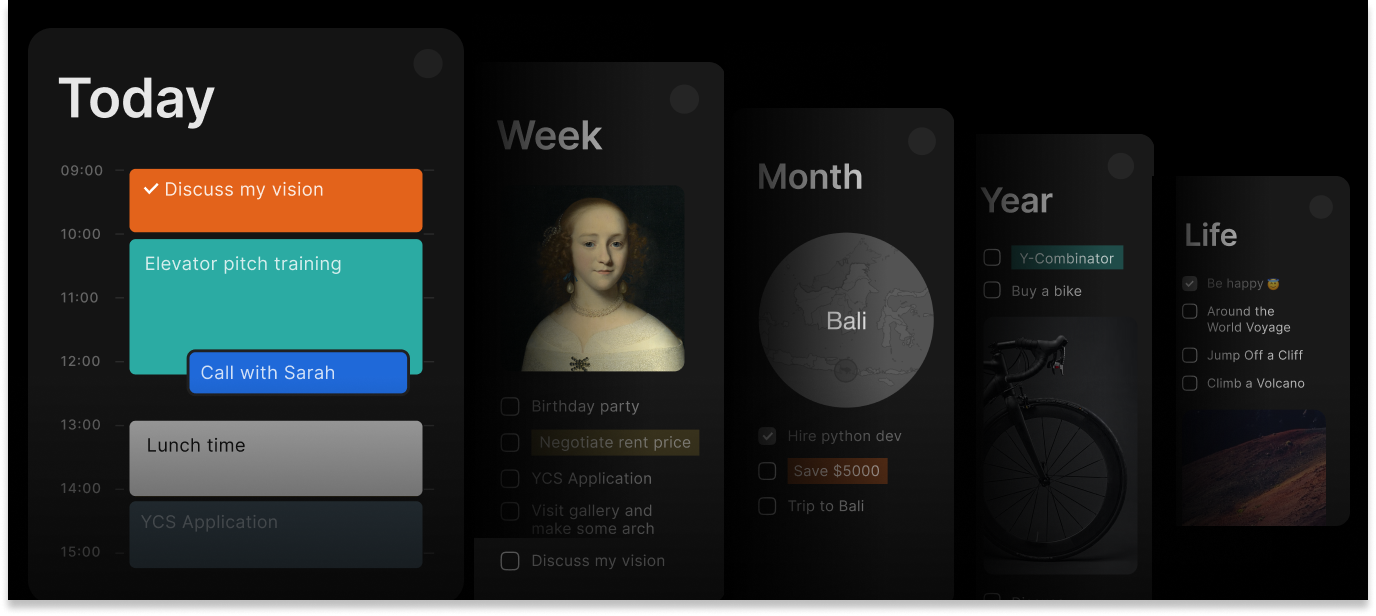Time Blocking: Master Your Schedule and Boost Productivity

Time blocking may sound like just another trendy term for productivity, but this simple technique could be the breakthrough you need to take control of your schedule. Curious about what is time blocking and why top entrepreneurs and high performers rely on it? We’ve created this full guide to demonstrate how this powerful method can help you take control of your most valuable resource: time.
What is Time Blocking as a Productivity and Time Management Method?
The strength of time blocking method lies in its purpose. Instead of reacting to urgent distractions, you proactively set time slots for tasks, projects, or deep work. This framework cuts decision fatigue, sharpens focus, and ensures your priorities get the attention they deserve, creating a balanced workflow for professionals in any field.
Time blocking suits everyone from coders to creatives because it’s customizable. You can craft a rigid structure if you’re a fan of a discipline or leave room for spontaneity, adjusting block lengths to fit your style.

Definition of Time Blocking
At its core, time blocking is a calendar-based scheduling technique where you allocate predetermined periods for specific tasks, projects, or categories of work. Unlike traditional to-do lists that simply enumerate what needs to be done, a time block system designates exactly when each task will be completed.
This method transforms your calendar from a passive repository of meetings and deadlines into an active tool for productivity management. Each time block becomes a commitment to yourself, a dedicated period where you focus exclusively on the designated activity without distractions or multitasking.
The principle behind time blocking is that work expands to fill the time available for it (Parkinson's Law). By creating artificial constraints through scheduled blocks, you naturally become more efficient and focused. Your calendar visually shows how you’re investing your time, offering instant insight into your priorities.
This flexible technique can be applied at various scales, from blocking out large chunks of time for major projects to creating smaller blocks for routine tasks like checking your emails or administrative work. The key is consistency and commitment to honoring the boundaries you've established yourself.
Benefits of Time Blocking
Enhanced Focus and Deep Work
Time blocking creates dedicated periods for focused work without interruptions. If you know that you have a specific, distraction-free time block allocated to a particular task, you are more likely to focus deeply on it rather than just skim the surface. This leads to higher quality work and quicker results without any extra effort, simply through good time management.
Reduced Decision Fatigue
By pre-determining when you’ll work on specific tasks, your mental energy stays sharp for actual work. You eliminate the constant decision-making about what to do next. This preservation of your cognitive resources making each day feel less draining.
Better Work-Life Balance
Time blocking helps you set clear boundaries between different types of activities. You can reserve time for family, hobbies, or self-care with the same care as work tasks. This human-first approach, though it takes effort, ensures you thrive without burnout.
Protection of Important Work
Time blocking ensures that your most critical tasks receive protected time slots before less important activities and mundane distractions can crowd them out. This proactive approach prevents important work from being perpetually postponed.
Increased Accountability
With time blocking, accountability comes naturally. You become more aware of how you really spend your time versus how you planned to spend it, creating opportunities for improvement and honesty with yourself.
Key advantages include:
- No multitasking, boosting efficiency
- Realistic expectations about what can be accomplished
- Clear communication of availability with colleagues and clients
- Greater sense of control over your schedule and priorities
- Better balanced personal and work life
- Reduced procrastination with clear commitments
How Does Time Blocking Work? The Time Blocking Process
- Planning Phase
- Allocating Time Slots
- Executing your blocks
- Reviewing and Adjust
Start your time blocking process with a planning session where you review upcoming commitments, deadlines, and priorities. This might happen weekly or daily, you choose. During this phase, you'll identify all the tasks that need time allocation and estimate their duration.
Next, assign specific time slots to each activity. How to time block effectively involves understanding your natural energy patterns, external constraints, and the different types of focus needed on each task. Add buffers between blocks to handle overruns or transition time. This human-centered approach balances focus with flexibility.
During each time block, dive in fully. Silence notifications, close email, and resist multitasking. It’s tough to stay disciplined, but sticking to the plan fuels deep focus. If you find your mind wandering or feel tempted to switch tasks, remind yourself: other tasks have their slots, so there's no need to worry about them during this period. This commitment transforms chaotic days into productive ones for any professional.
Each day or week, take a moment to consider how you have used your time. Which blocks worked? Which ran long? Note which activities were more or less challenging than expected. This reflection informs future planning and helps you develop more accurate time estimates. Don’t be harsh with yourself, all new approaches need time to adjust.
Use this data to refine your time block schedule. You might discover that certain types of tasks require more time than you initially thought, or that particular times of day are better suited for specific activities. Continuous adjustment based on real experience is key to developing an effective time blocking system.
Using Timestripe for Time Blocking
Timestripe elevates time blocking from a simple scheduling technique to a comprehensive productivity system. Our platform's intuitive design makes it easy to create, visualize, and manage your time throughout your life.
Visual Time Block Creation
Timestripe's visual interface makes planning a joy with a stunning calendar design. Drag and drop time blocks to schedule tasks effortlessly, seeing how daily work fits into big goals via our timeline view. With color-coded blocks, you can easily see how different blocks fit together, identify conflicts, and optimize your schedule for maximum productivity.
Smart Scheduling Planning
Timestripe’s time blocking thrives on our Horizons feature, linking daily tasks to long-term goals. Create boards to organize projects, ideal for developers tackling sprints or designers planning campaigns. Our human-first system adapts to your workflow, offering freedom to structure tasks your way for maximum focus.
Integration
With our mobile and web apps, managers or freelancers stay organized across devices, keeping schedules at their fingertips wherever they go.
Collaboration Features
Our Spaces elevate time blocking for teams. Share goals and tasks in collaborative workspaces, aligning remote developers or creative teams. Our tools foster seamless coordination, ensuring everyone focuses on shared priorities with clarity and purpose.
Progress Tracking
Our Progress Center and Insights provide detailed analytics about your actual time versus your planned allocation. These insights help you refine your time block planner approach and develop more accurate estimates for future planning. With Timestripe’s intuitive design, you gain insights to stay focused and achieve more.
Recommendations for Effective Time Blocking
Build in Buffer Time
Always include buffer time between blocks to account for tasks running over, bathroom breaks, and mental transitions between different types of activities. Most productivity experts recommend 15-30 minute buffers between significant blocks. Without a buffer, even a single delay can disrupt your entire schedule, causing stress and reducing the system's effectiveness.
Protect Your Blocks
Treat your time blocks as you would meetings with important clients or colleagues. This means resisting the temptation to 'quickly check your feed' during or allowing non-urgent interruptions to distract you.
Craft a Time Blocking Template
Standardise approaches for recurring types of work or regular responsibilities. Templates also help you to maintain a consistent approach, making it easier to develop productive routines and habits. Over time, you can refine these templates based on your experience to make them increasingly effective.
Schedule Breaks and Personal Time
Don’t skip time blocks for breaks, meals, or personal moments—they’re as vital as work. Protect these slots with the same zeal to avoid burnout and keep your energy humming.
Regular breaks prevent burnout and maintain energy levels throughout the day. Personal time blocks ensure that your life maintains balance and that important relationships and health habits receive adequate attention.
Review and Adjust Regularly
Carve out time weekly to review your time blocking game. What soared? What stumbled? Use our Timestripe Progress Center to spot patterns and fine-tune your approach. This reflection, though it feels like extra work, sharpens your skills, making each week smoother than the last.
Plan for Interruptions
Accept that interruptions are inevitable and plan for them within your system. You could designate certain time slots as 'interruptible' for less important tasks, while protecting others as 'focus time' that should only be interrupted in true emergencies.
Having a strategy for dealing with interruptions, such as scheduling them at a specific time or making quick notes for later action, helps you maintain the integrity of your work while responding to genuine requests.
Common Time Blocking Mistakes and How to Avoid Them
Over-Scheduling Every Minute
One of the most common mistakes is attempting to pack every single minute of the day through time blocking. It creates an inflexible schedule that becomes a source of stress rather than productivity enhancement.
Solution: Prioritize key time blocks for most important activities, leaving 30–40% of your day open for breaks, spontaneity, or unexpected needs. This balance keeps time blocking effective and comfortable.
Underestimating Task Duration
Most people consistently underestimate how long tasks will take, leading to rushed work and schedule disruptions. This common error creates pressure and weakens your time blocking plan’s reliability and creates unnecessary stress.
Solution: Track your actual time spent on different types of activities and use this data to inform future estimates. Add 25-50% to your initial guesses until you develop more accurate intuition about task duration.
Ignoring Energy Levels and Natural Rhythms
Scheduling demanding cognitive work during periods of low energy or routine tasks during periods of peak focus wastes your most valuable productive periods and makes difficult work even more challenging. Also, don't forget about your natural monthly energy fluctuations.
Solution: Pay attention to your natural energy patterns over several days or weeks. Schedule your most important and challenging work during peak energy periods, and reserve routine tasks to quieter times.
Failing to Prepare for Blocks
Starting a new time block without the necessary materials, information or mental preparation wastes time.
Solution: Allow time for preparation at the beginning of each block, or add preparation tasks to the preceding block. Make sure you have everything you need to work effectively before the designated start time.
Being Too Rigid
Although it is important to be committed to your goals, being completely inflexible can cause stress and prevent you from adapting to changing circumstances or unexpected opportunities.
Solution: Build flexibility into your system by allocating buffer time and designating "flexible slots" for changes. View your blocks as strong intentions rather than immutable commitments.
Neglecting to Block Personal Activities
Focusing solely on work-related tasks at the expense of exercise, meals, family time and self-care can lead to burnout and create unsustainable productivity patterns.
Solution: Block out time in your diary for personal activities and treat these with the same respect as work commitments. This should include meals, exercise, social time and activities that support your long-term well-being.
Not Adapting to Changes
Although life circumstances, work demands and personal priorities change over time, many people continue to use the same time-blocking approach regardless.
Solution: Regularly evaluate whether your time blocking system still meets your needs and helps you to achieve your current goals. Adjust the length of the blocks, their timing, and their categories as your responsibilities and priorities evolve.
Multitasking During Blocks
The temptation to check emails, respond to messages or work on multiple tasks during a dedicated time slot undermines the main advantage of time blocking: focused attention on a single activity.
Solution: Clear all potential distractions before starting each block. Use website blockers, silence notifications and make it clear that you are unavailable during periods of focused work.
Advanced Time Blocking Strategies
When you become a pro with regular time-blocking, there are some ways to spice things up.
Theme days – for the extra focus on one project or approach. For example, on Mondays you do planning and your chores, on Tuesdays – client work and updating project communication, and so on.
Theme days work particularly well for entrepreneurs, consultants, freelancers and others who have control over their schedule.
Priority Block Protection — Identify your 1-3 most important activities each day and give them the highest-quality time slots. These "priority blocks" should be scheduled during your peak energy periods and protected from interruptions more strictly than other blocks.
Conclusion: Transforming Your Productivity with Time Blocking
The key principles to remember:
- Start simple and gradually increase the complexity as you develop your discipline
- Focus on protecting your most important work
- Build flexibility into your system
- Use tools like Timestripe to make the process easier and more sustainable
- Regularly review and adjust your approach based on your own experience
Timestripe makes this transformation accessible and sustainable. Our intuitive interface, smart features, and approach to time management remove the friction from time blocking, allowing you to focus on the tasks that matter most.
Read next

Ready to take control of your schedule?
Start your trial of Timestripe today. Your future, more focused and less stressed self, will thank you for committing to intentional time allocation.
Get Started

